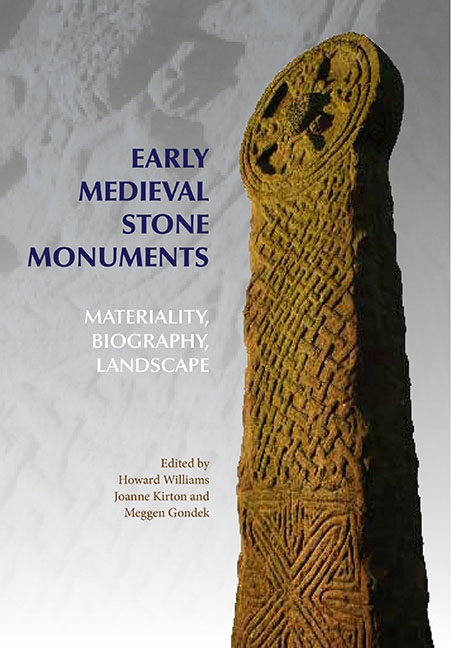Book contents
- Frontmatter
- Dedication
- Contents
- List of Illustrations
- List of Tables
- Acknowledgements
- 1 Introduction: Stones in Substance, Space and Time
- 2 Locating the Cleulow Cross: Materiality, Place and Landscape
- 3 Walking Down Memory Lane: Rune-Stones as Mnemonic Agents in the Landscapes of Late Viking-Age Scandinavia
- 4 Building Blocks: Structural Contexts and Carved Stones in Early Medieval Northern Britain
- 5 Memory, Belief and Identity: Remembering the Dead on Iniscealtra, Co. Clare
- 6 The Biographies and Audiences of Late Viking-Age and Medieval Stone Crosses and Cross-Decorated Stones in Western Norway
- 7 Lifeways in Stone: Memories and Matter-Reality in Early Medieval Sculpture from Scotland
- 8 A Stone in Time: Saving Lost Medieval Memories of Irish Stone Monuments
- 9 Hogbacks: the Materiality of Solid Spaces
- List of Contributors
- Index
1 - Introduction: Stones in Substance, Space and Time
Published online by Cambridge University Press: 21 May 2021
- Frontmatter
- Dedication
- Contents
- List of Illustrations
- List of Tables
- Acknowledgements
- 1 Introduction: Stones in Substance, Space and Time
- 2 Locating the Cleulow Cross: Materiality, Place and Landscape
- 3 Walking Down Memory Lane: Rune-Stones as Mnemonic Agents in the Landscapes of Late Viking-Age Scandinavia
- 4 Building Blocks: Structural Contexts and Carved Stones in Early Medieval Northern Britain
- 5 Memory, Belief and Identity: Remembering the Dead on Iniscealtra, Co. Clare
- 6 The Biographies and Audiences of Late Viking-Age and Medieval Stone Crosses and Cross-Decorated Stones in Western Norway
- 7 Lifeways in Stone: Memories and Matter-Reality in Early Medieval Sculpture from Scotland
- 8 A Stone in Time: Saving Lost Medieval Memories of Irish Stone Monuments
- 9 Hogbacks: the Materiality of Solid Spaces
- List of Contributors
- Index
Summary
A triad of research themes – materiality, biography and landscape – provide the distinctive foci and parameters of the contributions to this book. The chapters explore a range of early medieval inscribed and sculpted stone monuments from Ireland (Ní Ghrádaigh and O’Leary), Britain (Gondek, Hall, Kirton and Williams) and Scandinavia (Back Danielsson and Crouwers). The chapters together show how these themes enrich and expand the interdisciplinary study of early medieval stone monuments, in particular revealing how a range of different inscribed and sculpted stones were central to the creation and recreation of identities and memories for early medieval individuals, families, households, religious and secular communities and kingdoms.
Many narratives can be created about early medieval stone monuments (e.g. Hawkes 2003a; Orton and Wood 2007). This introduction specifically tackles early medieval stone monuments as ‘memory work’, material strategies by which selective remembering was orchestrated and mediated not simply by the raising of carved stone monuments but by their use, reuse, translation, reconfiguration and even destruction. This chapter then explores how the chosen themes create fresh avenues for early medieval research. Examples are considered in this introduction to illustrate the wider application and significance of the book’s themes in the study of stone monuments across early medieval Britain, Ireland and Scandinavia. In doing so, we acknowledge that many of the examples and issues addressed have wider import for the investigation of early medieval stones further afield across early medieval Europe and beyond. To begin, we use two case studies – one archaeological, one historical – that together draw out the centrality and interconnections of the book's three themes. We have deliberately avoided the most familiar monuments from debates in early medieval stone sculpture – such as the interpretation of the Ruthwell and Bewcastle monuments – so as to not embroil ourselves in the minutiae of worthy debates associated with these monuments that sit outside of the current focus of enquiry (e.g. É. Ó Carragáin 1999; 2003, Orton 2003; Orton and Wood 2007).
A MATERIAL OPENING: MAEN ACHWYFAN
In a field in north Wales is a relic of the Viking Age: the cross known as Maen Achwyfan (Whitford F12), situated near Whitford, Flintshire (Figs 1.1 and 1.2).
- Type
- Chapter
- Information
- Early Medieval Stone MonumentsMateriality, Biography, Landscape, pp. 1 - 34Publisher: Boydell & BrewerPrint publication year: 2015
- 3
- Cited by



